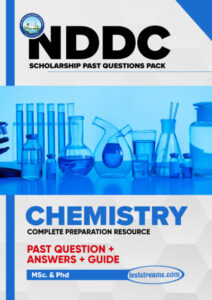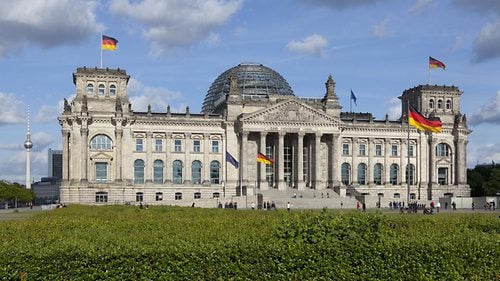NDDC Scholarship Chemistry Past Questions And Answers [Free – Download]
Are you an aspiring NDDC Scholarshipchemistry with dreams of making groundbreaking discoveries and pushing the boundaries of scientific knowledge? Look no further! In this blog post, we present the prestigious NDDC Scholarship in Chemistry, a golden opportunity to fuel your passion for chemistry and embark on an extraordinary scientific journey. Join us as we delve into the incredible benefits of this scholarship, the support it provides, and the pathway it opens to a fulfilling career in Chemistry
The NDDC Scholarship in Chemistry is designed to empower bright minds like yours to pursue higher education without the burden of financial constraints. Whether you’re aiming for a Bachelor’s, Master’s, or Ph.D. in Chemistry, this scholarship opens doors to prestigious institutions and world-class programs.
To excel in any examination, preparation is key, and that’s where our NDDC Scholarship Chemistry Past Questions and Answers come into play. These carefully selected materials provide you with a glimpse into the exam’s structure, question formats, and the depth of knowledge expected.
What Makes Our NDDC Scholarship Past Questions Stand Out?
- Comprehensive Coverage: Our collection spans multiple years, ensuring that you’re well-prepared for any surprises the exam might throw your way.
- Detailed Answers: Each question is accompanied by a comprehensive answer guide, allowing you to learn from your mistakes and reinforce your knowledge.
- Exam-Relevant Content: Our team of experts has painstakingly compiled the most relevant topics and questions that align with the NDDC Scholarship exam syllabus.
About NDDC Scholarship Test Style and Format (Updated)
NDDC overseas scholarship test was conducted by Cinfores-Ltd, between 2010 and 2015. Since 2016, the tests are now conducted by MEIL (MARG Educational International Limited).
The test usually comprises of 2 sections –
1. General questions which everyone will have to sit, and
2. Discipline-based questions.
For example, candidates in Engineering and Science related disciplines could take a mix of science-based questions like maths, English, physics, and chemistry for part 1, then discipline-specific questions for part 2.
2016 and 2017 tests contained more discipline-specific tests and English language tests as general papers. The test usually lasts between 30 to 60 minutes.
Sample Past Questions for NDDC Scholarship Aptitude Test – for CHEMISTRY candidates
Question 1: What is the atomic number of carbon?
A. 6
B. 12
C. 8
D. 16
Answer: A. 6
Question 2: Which of the following elements is a halogen?
A. Sodium (Na)
B. Chlorine
(Cl) C. Magnesium (Mg)
D. Potassium (K)
Answer : B. Chlorine (Cl)
Question 3: Balance the following chemical equation: H2 + O2 → H2O
A. 2H2 + O2 → H2O2
B. H2 + 2O2 → H2O
C. 2H2 + 2O2 → 2H2O
D. H2 + O2 → H2O2
Answer: C. 2H2 + 2O2 → 2H2O
Question 4: What is the chemical formula for sulfuric acid?
A. H2SO4
B. NaCl
C. CH4
D. CaCO3
Answer : A. H2SO4
Question 5: What is the pH value of a neutral solution?
A. 7
B. 10
C. 1
D. 0
Answer : A. 7
Question 6: What is the chemical symbol for gold?
A. Au
B. Ag
C. Go
D. Gd
Answer: A. Au
Question 7: Which of the following is a noble gas?
A. Oxygen
(O) B. Nitrogen
(N) C. Helium (He)
D. Carbon (C)
Answer : C. Helium (He)
Question 8: Which type of chemical bond involves the sharing of electrons between atoms?
A. Ionic bond
B. Covalent bond
C. Metallic bond
D. Hydrogen bond
Answer: B. Covalent bond
Question 9: What is the molar mass of water (H2O)?
A. 18 g/mol
B. 22 g/mol
C. 28 g/mol
D. 36 g/mol
Answer: A. 18 g/mol
Question 10: Which gas is produced during photosynthesis and used by plants for respiration?
A. Oxygen (O2)
B. Carbon dioxide (CO2)
C. Nitrogen (N2)
D. Methane (CH4)
Answer: A. Oxygen (O2)
Question11: What is the formula for sodium chloride (table salt)?
A. Na2SO4
B. NaCl
C. NaOH
D. NaHCO3
Answer : B. NaCl
Question12: What is the balanced equation for the combustion of methane (CH4) in oxygen (O2)?
A. CH4 + O2 → CO2 + H2O
B. CH4 + 2O2 → CO2 + 2H2O
C. CH4 + O2 → CO + H2O
D. CH4 + 2O2 → CO + 2H2O
Answer : B. CH4 + 2O2 → CO2 + 2H2O
Question 13: Which subatomic particle is responsible for the chemical properties of an element?
A. Proton
B. Neutron
C. Electron
D. Nucleus
Answer : C. Electron
Question 14: What is the balanced chemical equation for the reaction between sulfuric acid (H2SO4) and sodium hydroxide (NaOH)?
A. H2SO4 + NaOH → Na2SO4 + H2O
B. H2SO4 + 2NaOH → Na2SO4 + 2H2O
C. H2SO4 + NaOH → NaHSO4 + H2O
D. H2SO4 + 2NaOH → Na2SO3 + 2H2O
Answer : B. H2SO4 + 2NaOH → Na2SO4 + 2H2O
Question 15: What is the pH value of a solution with a hydrogen ion concentration of 1.0 x 10^-5 M?
A. 5
B. 7
C. 9
D. 11
Answer : A. 5
Question 16: Which gas is produced during the process of fermentation?
A. Oxygen (O2)
B. Carbon dioxide (CO2)
C. Nitrogen (N2)
D. Methane (CH4)
Answer : B. Carbon dioxide (CO2)
Question 17: What is the chemical formula for ammonia?
A. NH3
B. H2O
C. CO2
D. CH4
Answer: A. NH3
Question 18: Which of the following is a transition metal?
A. Sodium (Na)
B. Iron (Fe)
C. Calcium (Ca)
D. Phosphorus (P)
Answer: B. Iron (Fe)
Question 19: What is the atomic number of oxygen?
A. 6
B. 8
C. 16
D. 32
Answer : B. 8
Question 20: Which of the following elements is a metal?
A. Chlorine (Cl)
B. Oxygen (O)
C. Sodium (Na)
D. Nitrogen (N)
Answer : C. Sodium (Na)
Question 21: What is the chemical formula for hydrochloric acid?
A. H2SO4
B. HNO3
C. HCl
D. H3PO4
Answer: C. HCl
Question 22: Balance the following chemical equation: Fe + O2 → Fe2O3
A. 2Fe + O2 → Fe2O2
B. Fe + 2O2 → FeO3
C. 4Fe + 3O2 → 2Fe2O3
D. 3Fe + 2O2 → Fe3O2
Answer : C. 4Fe + 3O2 → 2Fe2O3
Question 23: Which of the following is the molecular formula of glucose?
A. C6H12O6
B. CH4
C. C2H6O
D. NaCl
Answer: A. C6H12O6
Question24: What is the name of the process by which a liquid turns into a gas at its surface?
A. Sublimation
B. Evaporation
C. Condensation
D. Precipitation
Answer : B. Evaporation





